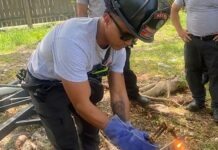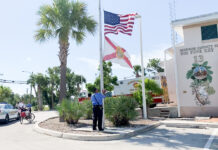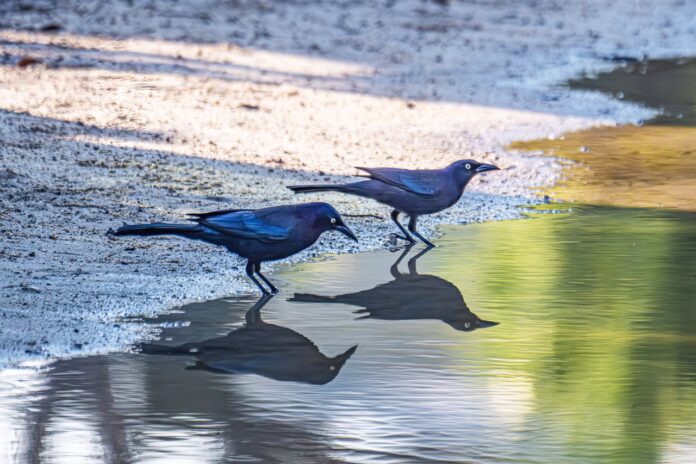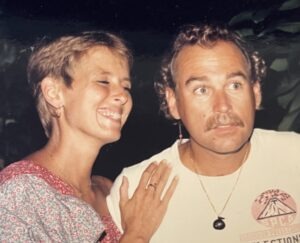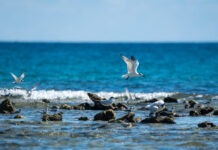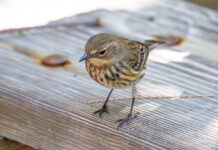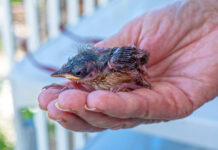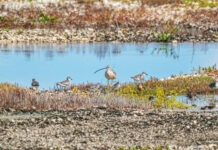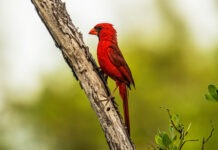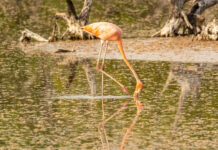I was hearing a red-winged blackbird but seeing a common grackle. Which was fine. If I wasn’t excessively comfortable with cognitive dissonance I wouldn’t be able to get out of bed most mornings. Or even most afternoons.
The grackle I could see. Actually there were two of them, down on the ground, sallying forth to drink from the puddle, then backing away into the shadow of the parked backhoe, then sallying forth to drink again. Sometimes they alternated in doing this, sometimes they did it as a pair.
I didn’t really try to find the red-winged blackbird. They’re here year-round and kind of hard to avoid as a species, and I did eventually, without really trying, catch sight of it giving its short-long-short, down-up-down whistle in the high branches of a nearby tree.
It was the grackles I was interested in. While most of the Florida population of the species is non-migratory, the Keys population disappears from the landscape sometime in September or October, and re-appears in late March or early April. And these were the first I had seen this year.
Grackles are some of the least loved creatures in the birding world.
Their physical traits can come off as simultaneously weird and, as the descriptor in their name implies, common. While they appear at first glance to be black, if you pay them enough attention you notice they have a purplish iridescence in the head and neck, which some people think looks like an oily sheen. They also have this bright, contrasting lunar-yellow eye that freaks some people out.
Then there is their voice. It has variously been described as a “harsh, metallic hiss,” “raspy” and “unmusical,” and akin to “the squeaking of an oilless wheelbarrow.”
I think another part of their public image issue is they come off as less-qualified crows, perhaps nearly equally cunning and canny, but with a far lower degree of the charm. Also, they are smaller, with pointier bills.
Crows are members of the smarty-pants corvid family, along with the smarter-than-your-average-bird jays and magpies. Grackles are with the icterids, who aren’t as sharp-witted but are generally prettier. Compared to the brilliant oranges and yellows of their oriole, meadowlark and oropendola cousins, though, grackles come off like Victorian undertakers or maladjusted goth kids, like the Skids on the TV show “Letterkenny.”
While an aggregation of crows is called a murder, an aggregation of grackles is called a plague. There is a reason for that beyond their looks and personality.
Grackles are one of the North American avian species that have benefited from human development of ecosystems. Before the Europeans arrived, population-wise they lived a respectable if modest existence in open woodlands and on the edges of forests. As the Europeans cleared the mature, old-growth forests and converted them into more agricultural habitats, the common grackle population spread and grew rapidly.
Two of the grackle’s great strengths are their adaptability and their sociability. They primarily eat seeds and insects – they even have a special ridge on their upper mandible called a keel that’s used to score and crack open hard seeds like acorns – but they will also eat eggs, chicks, small birds, small lizards and the occasional bit of garbage. They will sometimes follow plows and pick grubs and other invertebrates out of the overturned earth.
The thing that earned them the collective noun of plague, though, is their fondness for crops, especially corn and corn sprouts. Grackles will sometimes descend on fields of early-growth produce by the tens of thousands and go to town.
John James Audubon had something of a love/hate relationship with the common grackle. Describing the actions in his painting of them he wrote, “The male, as if full of delight at the sight of the havoc which he has already committed on the tender, juicy, unripe corn on which he stands, has swelled his throat, and is calling in exultation to his companions to come and assist him in demolishing it.”
“This is the tithe our (grackles) take from our planters and farmers; but it was so appointed, and such is the will of the beneficent Creator,” he added.
Another wag noted that resenting grackles for eating crops is like having an open bar and complaining that people got drunk.
This sanguineness was probably not shared by actual farmers.
The poet Ogden Nash, who is often wrongly credited with the lines, “A wonderful bird is the pelican / his beak can hold more than his belly can,” actually did write a short poem that pretty-well summed up the grackle:
The grackle’s voice is less than mellow,
His heart is black, his eye is yellow,
He bullies more attractive birds
With hoodlum deeds and vulgar words,
And should a human interfere,
Attacks that human in the rear.
I cannot help but deem the grackle
An ornithological debacle.
Personally, I’ve never had issues with grackles. As a species, they do what they have to do to survive and thrive. As the poet Waylon Jennings said of some other miscreants, they are making their way the only way they know how.
Also, I appreciate their DIY resourcefulness, which to my mind is more punk than goth.
Years ago, we fed our dog out on the back porch. When he wasn’t around, or when he was snoozing in the sun, the grackles would come in, grab a nugget, drop it in the water bowl, and disappear for a few minutes. Then they would come in, grab the softened kibble, gulp it down, and drop another nugget in the water bowl.
More recently, there was a time when our pool pump died for a couple months and the pool became something of a frog pond. Sometimes a palm frond would fall down on the edge and dip down into the water. And then a grackle or two would come in, sidle down the center vane of the frond, and nab their fill of tadpoles as they swam up to the surface to breathe.
I think it helps that in the Keys, with no agriculture, we get small gangs of them, not armies.
Christian Cooper, in his book “Better Living Through Birding,” had a sweet story about having a somewhat jaundiced eye toward grackles until he took a class of fourth graders birding in Central Park. It was a slow day, with not much to see. And then one of the kids spotted something.
Cooper said it was a grackle, and that he “nearly expectorated the name, as if to underscore just how common it was.”
“‘It’s beautiful,’” the kid said with a “reverent hush.”
He said for the first time in many years he actually looked at a grackle. And everything changed after that.
